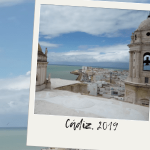Jerez de la Frontera: identity signs
Jerez de la Frontera is a municipality of the Bay of Cadiz located northwest of the province. Some of its main hallmarks that make Jerez a unique city are wine, flamenco, horses and motorcycling. We tell you a little about its history, culture and gastronomy.
If Jerez is your next destination with Hispatransfers we will take you from the Jerez airport to where you stay from € 3.92 per person.
Jerez and its history
From prehistory to the present, this municipality has been an important settlement due to its natural characteristics. Seven different cultures have passed through him: tartessos, Phoenicians, Romans, Visigoths, Muslims, Jews and Christians. The name of Jerez, comes from the Arabic ‘Sherish’, which means something like a wine jar, since in nearby villages they made artisanal wine. With the Christian Reconquest, the city is renamed Xerez, and, with the evolution of the Castilian language, Jerez. In this epoch also ‘of the Border’ is added to him, since the municipality was in the border with the nazarí kingdom of Granada.
Jerez takes importance during the nineteenth century with the industrialization and the arrival of the first railway line that linked it with the Port of Santa María in order to transport the wine from the city to nearby ports for export. At the end of this century, Jerez became the first city to install public lighting in Spain.
The different settlements that Jerez had throughout its evolution have been leaving biases in its personality, from the tartessos to the Arabs, passing through the Romans, the architecture and culture of this city has its characteristics.
Signs of Jerez identity
Knowing the history that surrounds this city, the four most characteristic elements are wine, horses, flamenco and motorcycling.
The wine of Jerez
The wine may be the most characteristic element of this city considering that its name and a large part of its economy are due to it. The first wine productions began with the Phoenicians. Since the Roman era the Jerez wine was exported to other cities, but it is from the 13th century when the wine industry begins to commercialize this product officially. It is at this stage when the Arabic term ‘Sherish’ expands to other regions or countries. In 1935 the city obtains the first Wine Denomination of Spain.
Flamenco in Jerez
This municipality is considered the cradle of the current flamenco. In the nineteenth and twentieth centuries, renowned flamenco artists such as Fernando Terremoto, La Paquera de Jerez, José Mercé and Miguel Flores were born, among many others. In addition, in Jerez is currently the Cátedra Andaluza de Flamencología and the Andalusian Center for Documentation of Flamenco. Among the different modalities of flamenco in Jerez, there are the bulería, the seguiriya, the soleá and the tango.
Jerez, the land of the horse
Since the Phoenician era the horses that were raised in these lands are outstanding for their physical characteristics and the care they received. The first horses‘Pura Sangre Español’ were born in Jerez when the Muslims crossed their horses with those who were Phoenician and Roman descendants. Jerez was also important in the polo, being one of the first Spanish cities where this equestrian sport was practiced. In 2018 it was named European City of the Horse.
The fair held in May is called Horse Fair because of the importance of this animal for the city and the agricultural and livestock origin of this fair.
Motorcycling in Jerez
Since the sixties, motorcycling has been part of the culture of Jerez de la Frontera. At this time the Grand Prize of Our Lady of Mercy was celebrated that was disputed by Jerez streets. When this competition became a tradition, an adequate place to compete in motorcycling races was built, the Circuito de Jerez was born. In 1987 the firstGrand Prix of Motorcycling Spain took place in this city, thus becoming one of the most important circuits in Europe.
In 2015 Jerez was named World Capital of Motorcycling by the World Motorcycling Federation. The name of the circuit was renamed Circuito de Jerez-Ángel Nieto in 2018 in homage to the pilot.
If you want to know firsthand the signs of Jerez identity, remember that you can book your private transfer from Jerez airport to where you stay from € 3.92 with Hispatransfers.





